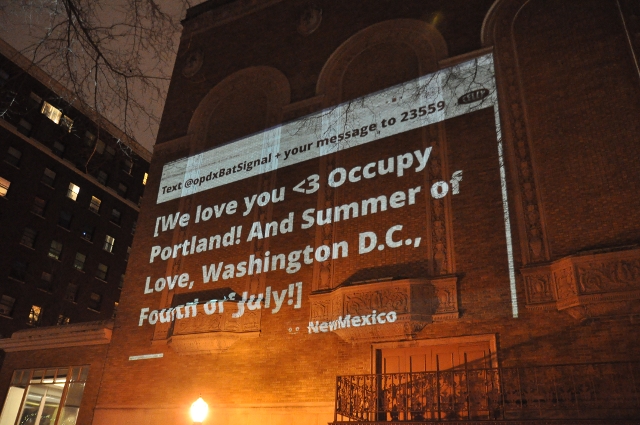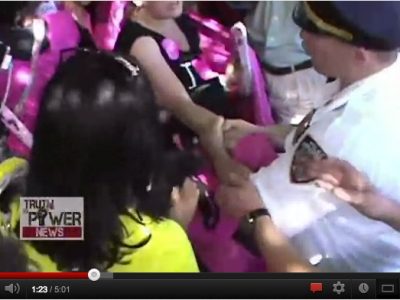by Mungen Cakes
So you want to do a Bat Signal. You want to project big ideas or fun images on the sides of homes, businesses, banks, bridges and highways (and never project on a church of any kind at any time unless you have permission). This DIY will give you the info you need to be successful your first time out. Contact Mungen at wbcable dot net if you need help. Also on Twitter as @Mungencakes.
Understanding Digital Projection
This Bat Signal DIY is for digital projection only, not for searchlight or klieg lights like in the TV series. Search lights require greater than 4 kilowatts of power from a 220V source. You just don’t go get a search light and plug it into the wall. Of course with that kind of power you can project onto low clouds. If you have the access and the power, by all means go ahead. That would be awesome.
Digital projector technology is much more accessible to the average jabroni and requires much less power. The two most common technologies are Liquid Crystal Display (LCD) and Digital Light Projection (DLP™) from Texas Instruments.
The imaging devices in an LCD projector are passive — light passes through the LCDs and are blocked by a pixel when that pixel is turned on. There are three small LCDs (~0.5 to 1.5 inch diagonal) in each projector, one each for red, blue, and green light. The light spectrum is split in the light path before the LCDs then recombined after the LCDs. This provides an image that is constant color. Lots of manufacturers make the panels for and manufacture these projectors; this is the more common of the two technologies.
The imaging device in a DLP™ projector is reflective. The surface of the Digital Micromirror Device (DMD) is made up of pixel sized mirrors that can be tilted electro-statically. There are DLP™ projectors with 3 devices and a light path similar to LCD projectors but that makes them prohibitively expensive. More commonly there is a color wheel in the light path that causes the colors to illuminate the DMD sequentially. The disadvantage to this is the color saturation is not as good as LCD, and some people are sensitive to the quickly flashing colors. But it also means that if you use a clear segment on the Color Wheel, the brightness of white can be boosted to a higher level. Another advantage is greater native contrast ratio: the blacks are blacker. These characteristics are advantages for a Bat Signal. Remember: contrast ratio specs are always bullshit.
Regardless of imaging technology, when using the projector as a Bat Signal you want to use the brightest setting. This will yield the worst looking colors, but with a Bat Signal you don’t care about that so much; the goal is brightness and visibility, so the content should be B&W anyway.
Brightness in projectors is measured in lumens (lm). The definition of lumens is average brightness in lux over a 1 meter square image area. A decent size image for a Bat Signal would be 10 feet wide or about 7 square meters. So a 7,000 lumen projector would put about 1,000 lux on the wall with a 10 foot wide image. See how easy? Figure the area in square meters of your projected image and divide that number into your projector’s lumens to see how bright your Bat Signal is going to be (the next section is about geometry and calculating image size).
Even cheap projectors nowadays can be 3,000 lm. That would be eminently usable for a 10 foot Bat Signal in a dark setting. Anything much below 300 lux is going to look pretty dim, so any projector dimmer than 2000 lm wouldn’t be suitable for a Bat Signal.
The resolution your Bat Signal needs, the number of pixels, depends on the content. For readability and practicality, Bat Signals should generally be showing only a few words or images at a time with big fonts. You don’t need high resolution for this. The lowest commonly available resolution will do, which is SVGA (800×600 pixels). A cheap Bat Signal can be done with a projector that costs less than $300 new, with limitations, but it could still be effective given the right location.
Both technologies use identical computer video signal front ends. The most common connector used for computer presentations is still VGA, an analog technology. HDMI is becoming available on more projectors/laptops and, since it is digital, would be preferable since you then don’t have to rely on signal strength from the source or an accurate analog-to-digital conversion in the projector to drive the imager full open. It’s possible that using the VGA input could make your Bat Signal dimmer than its full potential.
Some projectors have Type A USB multimedia inputs. This is a good way to go if you want to travel light. No laptop or computer necessary. Your content will be stored in jpeg format on your USB key. Just plug it into the projector and voilà, Bat Signal.
The website www.projectorcentral.com is a great place to research projector specifications.
Projection Geometry and Location
Figuring the size of your Bat Signal is easy. All you need to know is the distance from the projector to the surface to be projected on, the projection distance (PD), and the specification for your projector’s Throw Ratio (TR). Image width equals the PD divided by the TR. The smaller TR is, the bigger the image for a given distance to the wall, a simple direct ratio.
PD ÷ TR = Image Width
Most projectors have variable TR using a zoom ring on the projection lens. That makes it easy to make your image fit an area without having to be too exact.
Cheap projectors have cheap lenses and poorer TR, with a range of about 1.8~2.2. That means the image will be about half as wide as the PD: for a 10 foot wide Bat Signal you would need to be 20 feet away from the surface. This is actually an advantage for Bat Signallers. This set up is great for ground level, projecting onto street level walls from a parking lot, sidewalk, or a parked car. A projector with a good TR (<1.5) is not as useful for a Bat Signal; it would be like being a close talker, and no one wants that.
To get up in the air, to be visible from the skyline, you need to project over greater distances so TR becomes a bigger issue. You can tilt your projector up to elevate the image but then it will become keystoned, i.e. bigger at the top than at the bottom (this can be corrected in most projectors). You could also project greater distances by not using the whole active area of the projector, squishing the image into the center of the screen but this will result in a dimmer image.
To get big images onto big buildings across streets from other buildings with a TR of 1.8~2.2 would require a special location and/or a really bright projector. Streets with sidewalks are at least 50 feet wide resulting in a 100 foot wide image. The image for a 3,000 lm projector would only be 4 lux on the wall: kind of like being a soft talker, and no one wants that.
Projectors that are capable of projecting those distances are designed to take different lenses. A really long throw lens will have a TR range of 4~7. These projectors are also going to be brighter. A 6,000 lumen projector with the above-mentioned 50 foot PD at the longest throw would result in a 7 foot wide image that is 1700 lux up to a 12.5 wide image that is 550 lux. Not a soft talker, or a close talker, just right. Also with a lens with that kind of throw you could project over much greater distances than 50 feet assuming your target is big enough.
[caption id="attachment_2685" align="aligncenter" width="411" caption="bat signal figure 3, by Mungen"] [/caption]
[/caption]
The location is the toughest thing about putting up a successful Bat Signal. Look around your city’s skyline for buildings with big flat surfaces (and no windows), keeping an eye for where the projector will have to be. Parking garages are good locations to project from. So would be the tops of buildings or from the windows of buildings with a good line of sight to the projected surface.
This brings up the question of permission, assuming you give a rat’s ass about that. The location is also the key determinant on how “legal” your Bat Signal is. Parking garages have loitering rules, particularly those garages owned and operated by the city. Any public space is problematic without a permit. Arrest or citations should not be a concern if you are willing to take down your Bat Signal at a police officer’s request. Discretion is the better part of valor, live to project another day. Unless of course you want to make an even bigger statement than your signal could; a Bat Signal as Free Speech argument in the Supreme Court would be sweet. Commissioner Gordon would approve.
The ideal Bat Signal location would be a private property with a sympathetic owner/manager. This is also not easy to find, as they generally site liability as the reason they won’t allow a Bat Signal beaming from their property. The famous Verizon Building New York City Bat Signal was shone from someone’s apartment.
Power
Projectors eat up a lot of juice and most of that power goes to the lamp. Modern digital projectors use Ultra High Pressure (UHP) mercury arc lamps. Not the cleanest technology, they can contain more mercury than compact fluorescents: up to 100 mg. They should be disposed of correctly. Get information about recycling projector lamps at www.lamprecycle.org.
These lamps do not have a filament; they have an arc as if someone were welding. The surface temperature of the bulb is 900C (1650F), the temperature of the reflector and rear connections is 300C (570F). Don’t look at ‘em when they’re running and don’t touch ‘em until they cool down. The arc is a plasma of gaseous metals and salts. Because the contents of the bulb have been heated to a gaseous state there is high pressure inside the bulb, as much as 160 atmospheres. That means they can explode, and they sometimes do, in which case you have to be really careful when cleaning up to avoid (toxic) mercury exposure.
Power = Voltage x Current. A standard home outlet in the USA can deliver 15Amps at 110 Volts AC or 1650 Watts. In Europe it’s 220 VAC at 15A or 3300 W. A check of the safety label on the projector should tell which voltages are safe but most projectors are designed with international power supplies capable of running from 100-240VAC.
Total projector power usage is roughly equal to the lamp power+signal processing power+cooling fan power+efficiency. Lamp power varies from 150 to 400 watts. A cheap 3000 lm projector will likely have a 220 W lamp in it so total power usage is 220W lamp + 25W signal processing + 10W cooling fans + 25W efficiency = 280W. The markings on the safety labels for current draw are always calculated in such a way as to pass safety testing and/or reflect maximum theoretical current draw to provide safety margin, not to be accurate. The same projector that is actually drawing 280W will likely have a marking that says the power draw is >300W.
Laptops draw about 50W, so the total you need to power a 3000lm Bat Signal with a laptop video source is about 330W. This is easily supplied by a common 15A 110/220 Vac residential power circuit. But what do you do when you’re in a parking lot somewhere? You have three choices: steal power from someone (illegal in most states), get a gas or propane generator, or get a big battery with an AC power inverter.
You will get the most Bat Signal time if you use a generator. A 1000 W generator would do and wouldn’t be that expensive. The issues are emissions and the noise. Some generators can be pretty quiet but that will cost more. If you’re projecting from a parking garage you can put the generator on the level above or below you and drop the power cord down to make it quieter. Otherwise get a good long power cord to keep the generator out of your face.
Battery powered Bat Signals are silent but deadly. The problem with this power source is that the current at the battery is quite high even at a lower total power like 320W. To calculate the battery current, divide total power by the battery voltage. A 12V battery would be supplying a continuous 27A at 320W (320/12=26.67). Batteries have a rating, usually hard to find, of how long they can supply current, specified in Amp Hours (AH). A really good deep cycle marine battery rating would be 75-100AH. You would think then that you could get 3 hours of Bat Signal out of a single battery like this: 75AH divided by 27A = 2.8 Hours. Not so fast, kimosabe. Harder to find than the current capacity of a battery is what the maximum current is that would yield that total amount of time. This current is approximately what it would take to get to 20 hours at the specified AH; to get 75AH out of this high quality battery, you would need to draw less than 4A. The reality is you will only get at the most 45 minutes of Bat Signal time on a single battery at 320W. Remember, you are welding.
The inverter doesn’t need to be anything special. You don’t need a “true sine” generator to power a projector. The power front ends of projectors are designed with Power Factor Correction (PFC) circuits. They would even run on DC if you had a high enough voltage source. A lot of cheap inverters output power that is more like a square wave than a sine wave. This should not affect a projector at all. There is plenty of isolation between the power mains input and the lamp driver output. The main concern is to select an inverter that is rated at least twice your projector power to get good overhead and efficiency.
Content
This is the most fun part. You get to figure out what the Bat Signal will say to people. The rule of thumb should be: pithy. You’ll make people work too hard to read your Bat Signal if it is too busy. Take a look at the graphics the Bat Signal on the Verizon Building in NYC used; there are never more than a few words projected at a time. This is a link to that content: http://interoccupy.org/occupy-bat-signal/ (There is also a very nice DIY there). Keep it simple, stupid. Black and White with the ideas distilled to smaller than a bumper sticker word length.
Two of the things that made the Verizon Building Bat Signal so compelling was the transitions between slides and the animations. That’s much more interesting than abruptly changing images. Fade to black between images or fade into the next image. You can use VJ (Video DJ) mixing software or simple slide show program like Pulpmotion, Vertigo or PowerPoint to get these effects.
Make your content be the same aspect ratio as your projector so it fills the maximum area, achieves maximum brightness, and doesn’t look squished or fat. Aspect ratio is the ratio of the width of the image divided by the height. There are 3 aspect ratios for projectors:
4:3 (SVGA 800×600, XGA 1024×768)
16:10 (WXGA 1280×720 or 1366×768, WUXGA 1920×1200)
16:9 (1080p 1920×1080, 720p 1280×720)
Remember, anyone can see the Bat Signal so keep it clean.
Now you know, and knowing is half the battle.









